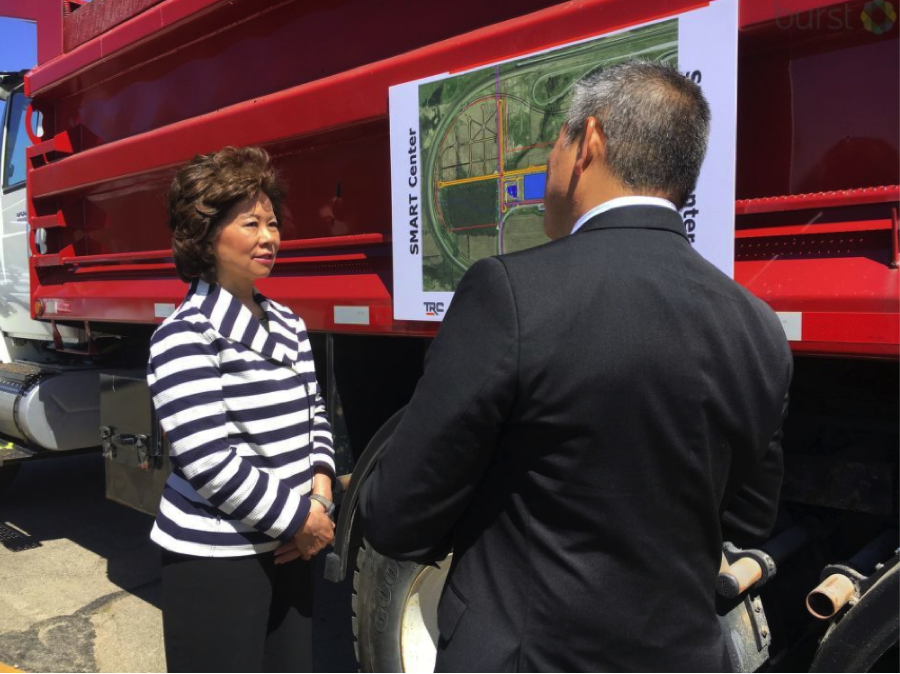 August 24, 2017 | Updated August 28, 2017 4:30pm
August 24, 2017 | Updated August 28, 2017 4:30pm
USDOT appears to be preparing for the release of its first policy statement for automated vehicles (AVs) under Secretary Elaine Chao.
Last week, the Office of Management and Budget posted a notice that USDOT and the National Highway Traffic Safety Administration (NHTSA) have submitted a document for regulatory review, titled “Voluntary Guidance on Automated Driving Systems.” This signals that Transportation Secretary Elaine Chao intends to keep to her timeline of publishing an update to the Federal Automated Vehicle Policy Statement (FAVP) next month – exactly a year after the release of the first FAVP by the Obama Administration.
The first FAVP was released by USDOT last September under Secretary Anthony Foxx, and was intended to be a living document that would be updated annually. Across four sections, the FAVP: provided manufacturers with guidance for safely testing and deploying AVs, delineated the roles federal/state/local entities in regulating AV development and operation, outlined NHTSA’s existing authorities, and listed potential authorities it may request from Congress.
While no further details were posted by OMB, sources familiar with recent work on the revision have told ETW that it will modify some of the more controversial portions of the original FAVP, such as the voluntary safety assessment letter (SAL) for manufacturers, the model state policy for AVs, and sections pertaining to pre-market approval.
Model State Policy
In particular, the model state policy has generated consternation among AV developers in the last year. The model state policy was intended to (a) provide a clear delineation of federal, state, and local authorities with respect to AV testing and operation, and (b) outline a potential method by which states could ensure the safe operation of AVs.
Key responsibilities are described in the below chart:
| Federal |
State |
| Setting Federal Motor Vehicle Safety Standards (FMVSS) for new motor vehicles and motor vehicle equipment (to which manufacturers must certify compliance before they sell their vehicles) |
Licensing human drivers |
| Enforcing compliance with the FMVSS |
Registering motor vehicles in their jurisdictions |
| Investigating and managing the recall and remedy of non-compliances and safety-related motor vehicle defects and recalls on a nationwide basis |
Enacting and enforcing traffic laws and regulations |
| Communicating with and educating the public about motor vehicle safety issues |
Conducting safety inspections, where States choose to do so |
| Issuing guidance for vehicle and equipment manufacturers to follow, such as the Vehicle Performance Guidance for HAVs presented in this Policy |
Regulating motor vehicle insurance and liability |
While most of the 20 states that have passed AV laws did not overextend their authorities, a small number of them have established laws that create significant regulatory and financial barriers to testing in their jurisdictions. For example: this March, New York State’s budget included a provision that created an intensive application process for testing AVs and imposed significant police escort fees that would charge manufacturers upwards of $100 per hour for each test drive, depending on distance travelled. And in Chicago this month, the City Council is considering an ordinance to ban all AVs from operating within its jurisdiction.
USDOT plans to sharpen the language in the revised FAVP to discourage states and their subdivisions from similar AV policies, which effectively amount to “backdoor regulations” on the design and performance of vehicles. This may include discouraging states from requiring prohibitively expensive police escorts or application fees, banning vehicles with autonomous functions, or requiring manufacturers to undergo intensive application processes.

Safety Assessment Letter
In the original FAVP, NHTSA recommended that states require manufacturers and other entities to submit a 15-point safety assessment letter (SAL) outlining their vehicles’ capabilities and limitations before they begin testing.
The SAL was created with the intention that AV developers would voluntarily submit it to NHTSA. More than anything, it was meant to encourage the many new entrants to the market from tech firms and research consortiums – many of which had not worked with NHTSA in the past – to establish open lines of communication with the national regulator of motor vehicle safety and performance.
But, by recommending that states require an SAL in applications to test, AV developers became concerned that the FAVP effectively made the voluntary document into a mandatory step for manufacturers. Moreover, developers have argued that many state agencies do not have the technical staff to understand how the vehicles worked – and whether they were capable of operating safely.
Furthermore, experts have questioned the wisdom of the “Ethical Considerations” section of the SAL, as programming ethical decisions in advance simply cannot solve some of the ethical conundrums for AVs. For a deeper dive into this issue, see Paul Lewis of Eno’s recent article in ETW.
As a result, it is likely that the upcoming FAVP revision will emphasize the voluntary part of “Voluntary Guidance on Automated Driving Systems” in order to counteract the emergence of state AV laws that are imposing restrictions on testing based on the SAL.
This is because the voluntary guidance is meant to be just that – guidance. So far, NHTSA has delayed the creation of a national framework for AV testing and deployment; an AV rulemaking was not even included in the USDOT Unified Agenda for this year that outlined current, inactive, & pending regulatory actions.
As ETW wrote in July, the USDOT’s preamble to the unified agenda – the document that describes those plans for regulatory action in next 12 months – only mentioned automated systems as an area of focus in passing.
Secretary Chao has held off on conducting rulemakings for a few reasons:
- Congressional Action: House Republicans are pushing for the speedy passage of H.R. 3388, the SELF DRIVE Act, when they return in August. In its current form, it would direct DOT to establish AV standards within 24 months of passage – it would only make sense for USDOT to see where this goes (and if it gets mired in partisan battles) before they initiate a rulemaking. Even if the SELF DRIVE Act does pass when it goes to the House floor, the Senate is continuing to work on its own AV legislation that reportedly contains significant differences – especially with regard to preempting state AV laws.
- NHTSA is a Vehicle Without a Driver: Don’t look now, but NHTSA still does not have an administrator – and President Trump has not even nominated someone yet. Chao will need an Administrator to be lead NHTSA’s efforts in communicating the FAVP to manufacturers and Congress – especially if there is an infrastructure package coming down the pike.
- Technical Realities: Although AVs have come into the public eye as an imminent technological breakthrough, we are still far away from having testing procedures that can reasonably prove their safety in most situations on the road. These challenges were thoroughly described in a report led by Dr. Nidhi Kalra of RAND. However, AV research centers are making steady progress in developing a means of testing AV safety in faster and more cost-efficient ways. One of the most notable was detailed in a recent study by the University of Michigan’s Mcity research center.
The Bottom Line
Next month’s FAVP update will likely include a revamped SAL that manufacturers sign and send to NHTSA directly and voluntarily. It will rescind USDOT’s blessing for states to establish backdoor regulations around AV performance and design by requiring SALs.
Going a step further, the revised FAVP may eliminate remove some of the Foxx-era proposals for expanded regulatory authorities, given the significant pushback on pre-market approval; and expand the role of the 10 USDOT AV Proving Grounds in advancing the national understanding of AVs.

 August 24, 2017 | Updated August 28, 2017 4:30pm
August 24, 2017 | Updated August 28, 2017 4:30pm


